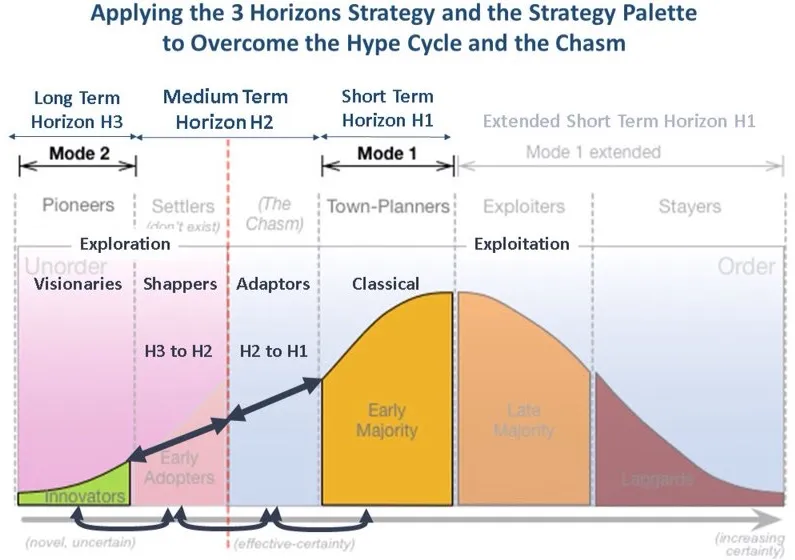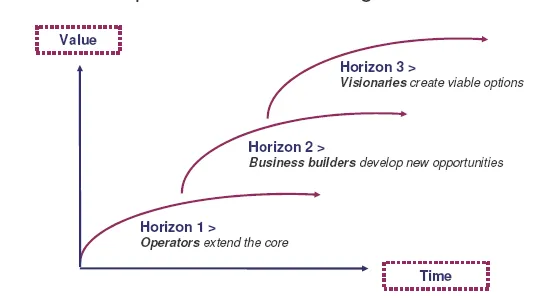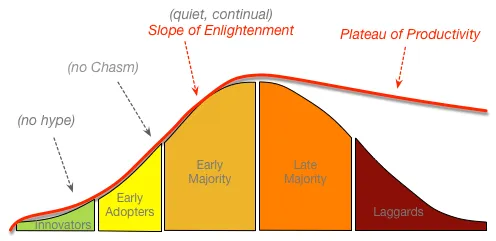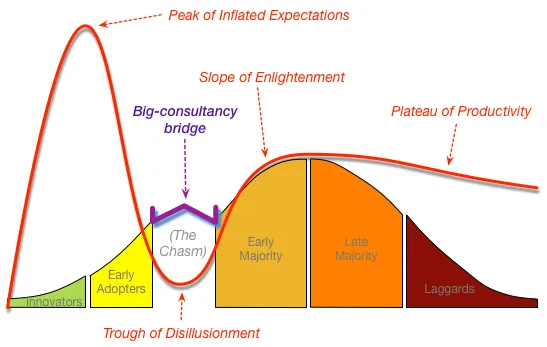Technology-adoption and time-horizons
Blog: Tom Graves / Tetradian
This one’s a follow-up to a recent post, ‘Technology-adoption, Wardley-maps and Bimodal-IT‘, which adds the theme of time-horizons for strategy.
The starting-point was a kind Tweet-comment by Ralph-Christian Ohr about that post of mine:
- RT @ralph_ohr Great post by @tetradian on why we have to think tri-modal, rather than dual #innovation – similarities to my model. bit.ly/2a5D0P8
To which Jairo H Venegas sent a quick Tweet-response:
- RT @jairohvenegas: @ralph_ohr we may apply bidirectional bridge H2 to solve the puzzle #3Horizons #Innovation #Strategy cc @tetradian https://t.co/ykxVC2mVF3
His Tweet points to this modified version of one of the graphics from that previous post of mine:

I’ll admit that at first I just went “What the…???” – and then realised that I needed to do a decent search on ’3 Horizons Strategy’, because I didn’t have a clue what it was. Oops…
‘Oops’ indeed – I certainly should have known about this one, because it seems to be one of the core models for mainstream strategy:
- McKinsey: ‘Enduring Ideas: The three horizons of growth‘
- Paul Hobcraft: ‘The three-horizon approach to innovating‘
- Tim Kastelle: ‘Linking Innovation to Strategy, part 3‘
The ‘Three Horizons’ idea seems to have started with a 1999 book, Alchemy of Growth, by Meghai, Coley and White, and is perhaps summarised in its simplest form by this graphic from Paul Hobcraft:

Often there are other tags or attributes put on these time-horizons, and even specific times too:
- Horizon 1: Extend; Current products; Short-term; 0-18 months
- Horizon 2: Build; Next-generation products; Medium-term; 12-36 months
- Horizon 3: Create; Emerging products; Long-term; 24-72 months
But those time-distances in months are all a bit blurry and uncertain, and some writers argue that the horizons should be seen as relative rather than absolute anyway, so we probably don’t need to go into any depth on that.
Which leaves us with Venegas’ four labels and his link-arrows and bridges across the Rogers and Wardley roles.
The labels themselves – Classical, Adaptors, Shappers and Visionaries – do all sort-of make sense relative to each other (though I’m presuming here that ‘Shappers’ is actually ‘Shapers’). Likewise the link-arrows and bridges do (mostly) make sense; and likewise too for ‘Exploration’ with Unorder, and ‘Exploitation’ with Order.
The catch, though, is that the mapping to the underlying Rogers technology-lifecycle doesn’t work – and that kind of invalidates the whole thing…
The most obvious problem is that Venegas has placed the Adaptors role in the space denoted by Geoffrey Moore’s ‘the Chasm’. But the catch is that the Chasm isn’t a role – it’s a dysfunctional artefact of a dysfunctional response to the dysfunctional excess of hype developed in the Horizon 3 area, Rogers’ role of Innovators:

The point here is that if the hype is kept properly at bay, there’s no ‘the Chasm’:

Which, in turn, would mean that if things were done properly, there would therefore be no Adaptors in Venegas’ mapping. Which doesn’t quite make sense.
What also wouldn’t make sense would be to cross-map the Adaptors with the ‘big-consultancy bridge‘ over the Chasm:

The reason why that doesn’t make sense is that, as explained in the ‘Bimodal-IT’ post, the one thing that the big-consultancies try to avoid having to do is context-specific adaptation – they make their money by putting pre-scripted cookie-cutter ‘solutions’ in place, not point-by-point customisations.
Either way, that mapping just doesn’t work. Sorry…
Another option, though, would be to move the mapping one step further, over on the far side of the (preferably-nonexistent) Chasm, to give us this:
- ‘Visionaries’ : Innovators : Pioneers
- ‘Shapers’ : Early Adopters : Settlers
- ‘Adaptors’ : Early Majority : Town-Planners
- ‘Classical’ : Late Majority : Exploiters
And to me at least, that does make sense. Definitely useful.
The other question is about the time-horizons themselves. Assuming that, as per the ‘Bimodal-IT’ article, the group we’re really talking about here are executives who are supposedly responsible for strategic choices, their natural habitat is in the world infested by the big-consultancies – namely the Early-Majority / Town-Planners space. A key characteristic of this group is that they’re always desperately hungry for The Next New Shiny Thing that might give some kind of competitive-advantage – which is why they’re such easy targets for big-vendor hype – but they’re also deeply change-averse – because they’re supposed to hit their predicted ‘targets’, quarter after quarter, in what is in reality an increasingly-unstable world. To be blunt, these are the people who’ve actually killed anything resembling real-strategy in most large organisations. And the one thing they don’t have is a realistic concept of time – or, in particular, of the future, or of futures, with all of its inherent-uncertainty.
Hence, for example, the typical depiction of those time-horizons would be roughly as follows:
- Horizon 3: 24-72 months
- Horizon 2: 12-36 months
- Horizon 1: 0-18 months
- Horizon 0: NOW! to past
(The Horizon 0 maps to the ‘Classical’ group, the Exploiters, the people focussed on ‘keeping the lights on’ and suchlike. Also a more realistic view of how long it takes to develop a new technology could well be five to ten times longer than those periods listed above, but they’ll do for now.)
Yet with the executives, we’re not dealing with a sensible, structured, Rogers-like relationship between distinct roles and responsibilities, each passing the baton from one stage to the next. Instead, to be blunt, in too many cases we’re dealing with people who have the distractability of a two-year-old hyped-up on red food-dye, and – if we’re lucky – an attention-span that’s maybe as much as that of a gnat. And their concept of the Three Horizons would usually be – at best – something more like this:
- Horizon 0: forget it, it’s Somebody Else’s Problem
- Horizon 1: current quarter
- Horizon 2: next quarter
- Horizon 3: whenever the next annual planning-cycle might be
In other words, their notion of ‘Horizon 3′ wouldn’t stretch out even halfway towards any ‘normal’ Horizon 1, let alone towards anything more realistic. There’s no way that a real-world technology-adoption lifecycle will even begin to make sense for a mindset like that. And yes, these are the people who are supposedly in charge of ‘strategy’ in most large organisations – the kind of people who seriously believe that “Last year plus 10%” is a genuine strategy.
Yeah. Ouch…
So the short answer to all of this is that whilst Venegas’ mapping is undoubtedly nice, and clever, and pretty, and maybe even useful for crazies like us in enterprise-architecture and the like, it’s unlikely to help at all with the people who really need to understand and act on what that mapping says – namely those so-called ‘strategic’-executives. And the reason why it won’t help is that they just won’t get it. Not just won’t get it, but can’t; or even more, dare not get it – because their status, jobs, income and bonuses. in so many cases, will depend on not-getting it, but instead focussing solely on the ‘controllable’ short-term.
So whilst Venegas is not ‘wrong’ as such, I don’t see any easy way out of this one. There’s a thin chance that some of those executives might eventually start to understand some of the more accessible types of practical tools, such as Wardley maps; I’m hoping that I might soon be able to add some of my tools such as SCAN and SCORE into that category too. But the reality, I fear, is that the only thing we can do is wait it out, in the same sense that it’s sometimes said that “science proceeds by funerals” – maybe not literal funerals as such, in this case, but at least until evolution takes enough of a toll amongst the short-termist dross. Whether any of us can afford to wait that long is another question entirely, of course…
Oh well.
Comments, anyone, perhaps?